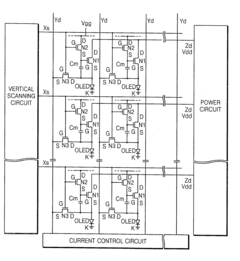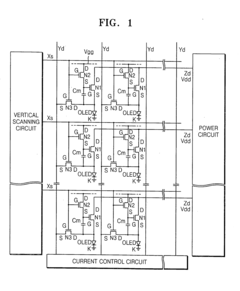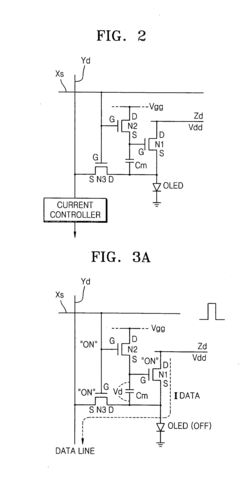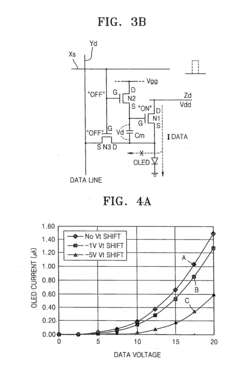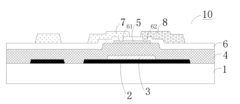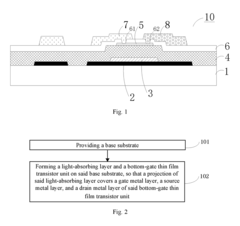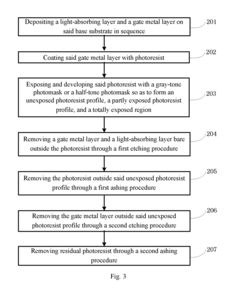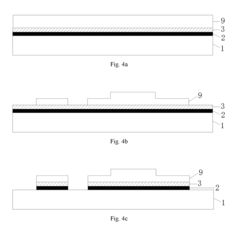How AMOLED addresses power consumption in smartwatches?
JUL 17, 20259 MIN READ
Generate Your Research Report Instantly with AI Agent
Patsnap Eureka helps you evaluate technical feasibility & market potential.
AMOLED Tech Evolution
AMOLED technology has undergone significant evolution since its inception, particularly in addressing power consumption challenges in smartwatches. The journey began with the development of basic OLED displays, which offered advantages over traditional LCD screens in terms of power efficiency and display quality.
In the early stages, AMOLED displays faced issues with high power consumption, especially when displaying bright colors or white backgrounds. This limitation was particularly problematic for smartwatches, where battery life is a critical factor. However, advancements in pixel architecture and manufacturing processes led to substantial improvements in energy efficiency.
One of the key milestones in AMOLED evolution was the introduction of sub-pixel rendering techniques. This innovation allowed for more efficient use of individual pixels, reducing the overall power consumption while maintaining image quality. Additionally, the development of more sophisticated power management systems enabled dynamic adjustment of pixel brightness based on content and ambient light conditions.
Another significant advancement was the implementation of dark mode interfaces. By leveraging AMOLED's ability to completely turn off individual pixels when displaying black, smartwatch manufacturers could dramatically reduce power consumption in user interfaces and applications. This feature became a game-changer for extending battery life in AMOLED-equipped smartwatches.
The evolution of AMOLED technology also saw improvements in display driver ICs (Integrated Circuits). These advancements allowed for more efficient control of the display, further reducing power consumption. Manufacturers also focused on optimizing the organic materials used in AMOLED panels, developing compounds that required less energy to emit light while maintaining or even improving color accuracy and brightness.
Recent years have witnessed the emergence of low-temperature polycrystalline oxide (LTPO) backplane technology. LTPO allows for variable refresh rates, enabling smartwatches to dynamically adjust their screen refresh rate based on the content being displayed. This innovation significantly reduces power consumption during static or low-motion scenarios, which are common in smartwatch usage.
The ongoing evolution of AMOLED technology continues to push the boundaries of power efficiency. Current research focuses on developing more energy-efficient organic materials, improving pixel structures for better light emission, and enhancing power management algorithms. These efforts aim to further reduce the power consumption of AMOLED displays in smartwatches, ultimately leading to longer battery life and improved user experience.
In the early stages, AMOLED displays faced issues with high power consumption, especially when displaying bright colors or white backgrounds. This limitation was particularly problematic for smartwatches, where battery life is a critical factor. However, advancements in pixel architecture and manufacturing processes led to substantial improvements in energy efficiency.
One of the key milestones in AMOLED evolution was the introduction of sub-pixel rendering techniques. This innovation allowed for more efficient use of individual pixels, reducing the overall power consumption while maintaining image quality. Additionally, the development of more sophisticated power management systems enabled dynamic adjustment of pixel brightness based on content and ambient light conditions.
Another significant advancement was the implementation of dark mode interfaces. By leveraging AMOLED's ability to completely turn off individual pixels when displaying black, smartwatch manufacturers could dramatically reduce power consumption in user interfaces and applications. This feature became a game-changer for extending battery life in AMOLED-equipped smartwatches.
The evolution of AMOLED technology also saw improvements in display driver ICs (Integrated Circuits). These advancements allowed for more efficient control of the display, further reducing power consumption. Manufacturers also focused on optimizing the organic materials used in AMOLED panels, developing compounds that required less energy to emit light while maintaining or even improving color accuracy and brightness.
Recent years have witnessed the emergence of low-temperature polycrystalline oxide (LTPO) backplane technology. LTPO allows for variable refresh rates, enabling smartwatches to dynamically adjust their screen refresh rate based on the content being displayed. This innovation significantly reduces power consumption during static or low-motion scenarios, which are common in smartwatch usage.
The ongoing evolution of AMOLED technology continues to push the boundaries of power efficiency. Current research focuses on developing more energy-efficient organic materials, improving pixel structures for better light emission, and enhancing power management algorithms. These efforts aim to further reduce the power consumption of AMOLED displays in smartwatches, ultimately leading to longer battery life and improved user experience.
Smartwatch Power Demand
Smartwatches have become increasingly popular in recent years, offering users a convenient way to access information and track their health metrics. However, these devices face significant power consumption challenges due to their compact size and limited battery capacity. The power demand of smartwatches is primarily driven by several key factors that impact their overall energy consumption.
Display technology is one of the most significant contributors to power consumption in smartwatches. Traditional LCD displays require constant backlighting, which can drain the battery quickly. This has led to a shift towards more energy-efficient display technologies, such as AMOLED (Active-Matrix Organic Light-Emitting Diode) screens, which can selectively illuminate only the necessary pixels, thereby reducing power consumption.
Processor efficiency also plays a crucial role in determining the power demand of smartwatches. As these devices become more sophisticated, they require more powerful processors to handle complex tasks and applications. However, more powerful processors typically consume more energy, creating a trade-off between performance and battery life. Manufacturers are continually working on developing more energy-efficient processors specifically designed for wearable devices.
Connectivity features, such as Bluetooth, Wi-Fi, and cellular capabilities, contribute significantly to the power demand of smartwatches. These wireless technologies enable smartwatches to communicate with smartphones and other devices, but they also consume a considerable amount of energy, especially when constantly active or searching for signals.
Sensors and health monitoring features are another major source of power consumption in smartwatches. These devices often include various sensors like accelerometers, gyroscopes, heart rate monitors, and GPS receivers. While these sensors provide valuable data for health and fitness tracking, they also require continuous power to operate effectively.
Battery technology limitations further compound the power consumption challenges in smartwatches. The small form factor of these devices restricts the size and capacity of batteries that can be used. This limitation puts pressure on manufacturers to optimize every aspect of the smartwatch's design and functionality to maximize battery life.
Software optimization is another critical factor in managing power demand. Efficient operating systems and applications can significantly reduce energy consumption by minimizing background processes, optimizing data syncing, and implementing power-saving modes. Manufacturers and software developers are constantly refining their algorithms and user interfaces to strike a balance between functionality and power efficiency.
Display technology is one of the most significant contributors to power consumption in smartwatches. Traditional LCD displays require constant backlighting, which can drain the battery quickly. This has led to a shift towards more energy-efficient display technologies, such as AMOLED (Active-Matrix Organic Light-Emitting Diode) screens, which can selectively illuminate only the necessary pixels, thereby reducing power consumption.
Processor efficiency also plays a crucial role in determining the power demand of smartwatches. As these devices become more sophisticated, they require more powerful processors to handle complex tasks and applications. However, more powerful processors typically consume more energy, creating a trade-off between performance and battery life. Manufacturers are continually working on developing more energy-efficient processors specifically designed for wearable devices.
Connectivity features, such as Bluetooth, Wi-Fi, and cellular capabilities, contribute significantly to the power demand of smartwatches. These wireless technologies enable smartwatches to communicate with smartphones and other devices, but they also consume a considerable amount of energy, especially when constantly active or searching for signals.
Sensors and health monitoring features are another major source of power consumption in smartwatches. These devices often include various sensors like accelerometers, gyroscopes, heart rate monitors, and GPS receivers. While these sensors provide valuable data for health and fitness tracking, they also require continuous power to operate effectively.
Battery technology limitations further compound the power consumption challenges in smartwatches. The small form factor of these devices restricts the size and capacity of batteries that can be used. This limitation puts pressure on manufacturers to optimize every aspect of the smartwatch's design and functionality to maximize battery life.
Software optimization is another critical factor in managing power demand. Efficient operating systems and applications can significantly reduce energy consumption by minimizing background processes, optimizing data syncing, and implementing power-saving modes. Manufacturers and software developers are constantly refining their algorithms and user interfaces to strike a balance between functionality and power efficiency.
AMOLED Power Challenges
AMOLED displays in smartwatches face several power consumption challenges due to their unique operating environment and user expectations. One of the primary issues is the constant need for screen visibility, especially in outdoor settings. This requires higher brightness levels, which significantly increases power draw. The small form factor of smartwatches also limits battery capacity, making power efficiency crucial.
Another challenge is the always-on display feature, popular in many smartwatch models. This functionality demands continuous power supply, even when the device is not actively used. Balancing the need for constant information display with power conservation is a delicate task for AMOLED technology in smartwatches.
The dynamic nature of smartwatch usage patterns also presents power management difficulties. Frequent transitions between active and idle states, coupled with varying levels of screen content complexity, require sophisticated power control mechanisms. AMOLED displays must adapt quickly to these changes while maintaining optimal power efficiency.
Color reproduction and contrast, key strengths of AMOLED technology, also contribute to power consumption challenges. Achieving vibrant colors and deep blacks, which are hallmarks of AMOLED displays, often requires more power, especially in high-brightness scenarios. Balancing visual quality with power efficiency is an ongoing challenge for smartwatch manufacturers.
The refresh rate of AMOLED displays in smartwatches is another area of concern. Higher refresh rates provide smoother animations and better responsiveness but come at the cost of increased power consumption. Finding the right balance between performance and power efficiency is crucial, especially given the limited battery capacity of smartwatches.
Thermal management is an additional challenge related to power consumption. As AMOLED displays consume power, they generate heat. In the confined space of a smartwatch, effective heat dissipation is difficult, potentially leading to increased power consumption and reduced display lifespan if not properly managed.
Lastly, the integration of advanced features like touch sensitivity, force touch, and in-display fingerprint sensors adds complexity to power management. These features often require additional layers or components in the display stack, which can impact overall power efficiency and require careful optimization to maintain the balance between functionality and power consumption.
Another challenge is the always-on display feature, popular in many smartwatch models. This functionality demands continuous power supply, even when the device is not actively used. Balancing the need for constant information display with power conservation is a delicate task for AMOLED technology in smartwatches.
The dynamic nature of smartwatch usage patterns also presents power management difficulties. Frequent transitions between active and idle states, coupled with varying levels of screen content complexity, require sophisticated power control mechanisms. AMOLED displays must adapt quickly to these changes while maintaining optimal power efficiency.
Color reproduction and contrast, key strengths of AMOLED technology, also contribute to power consumption challenges. Achieving vibrant colors and deep blacks, which are hallmarks of AMOLED displays, often requires more power, especially in high-brightness scenarios. Balancing visual quality with power efficiency is an ongoing challenge for smartwatch manufacturers.
The refresh rate of AMOLED displays in smartwatches is another area of concern. Higher refresh rates provide smoother animations and better responsiveness but come at the cost of increased power consumption. Finding the right balance between performance and power efficiency is crucial, especially given the limited battery capacity of smartwatches.
Thermal management is an additional challenge related to power consumption. As AMOLED displays consume power, they generate heat. In the confined space of a smartwatch, effective heat dissipation is difficult, potentially leading to increased power consumption and reduced display lifespan if not properly managed.
Lastly, the integration of advanced features like touch sensitivity, force touch, and in-display fingerprint sensors adds complexity to power management. These features often require additional layers or components in the display stack, which can impact overall power efficiency and require careful optimization to maintain the balance between functionality and power consumption.
Current Power Solutions
01 Power-saving display techniques
AMOLED displays employ various power-saving techniques to reduce energy consumption. These include adaptive brightness control, selective pixel activation, and optimized driving schemes. By intelligently managing the display's power usage based on content and ambient conditions, these methods significantly improve battery life in devices using AMOLED screens.- Power-saving display techniques: AMOLED displays employ various power-saving techniques to reduce energy consumption. These include adaptive brightness control, selective pixel activation, and optimized driving schemes. By intelligently managing display brightness and selectively activating pixels based on content, power consumption can be significantly reduced without compromising image quality.
- Compensation circuits for power efficiency: Compensation circuits are implemented in AMOLED displays to improve power efficiency. These circuits address issues such as threshold voltage variations and mobility degradation in thin-film transistors. By compensating for these factors, the display can operate more efficiently, reducing overall power consumption and extending battery life in mobile devices.
- Low-power driving methods: Novel driving methods are developed to minimize power consumption in AMOLED displays. These include low-frequency driving, frame rate control, and voltage optimization techniques. By reducing the frequency of pixel updates and optimizing voltage levels, significant power savings can be achieved without noticeable impact on display performance.
- Power management for different display modes: AMOLED displays implement sophisticated power management strategies for various display modes. These include optimized power schemes for always-on displays, dark mode, and high dynamic range content. By tailoring power consumption to specific display requirements, overall energy efficiency is improved across different usage scenarios.
- Pixel circuit designs for reduced power consumption: Advanced pixel circuit designs are developed to minimize power consumption in AMOLED displays. These designs focus on reducing leakage current, improving charge retention, and optimizing transistor characteristics. By enhancing the efficiency of individual pixel circuits, the overall power consumption of the display can be significantly reduced.
02 Pixel compensation circuits
Implementing pixel compensation circuits in AMOLED displays helps to maintain uniform brightness and reduce power consumption. These circuits compensate for variations in transistor characteristics and OLED degradation, ensuring consistent performance over time. By optimizing the current flow to each pixel, these circuits contribute to overall power efficiency.Expand Specific Solutions03 Low-power driving methods
Advanced driving methods for AMOLED displays focus on reducing power consumption while maintaining image quality. These techniques include low-frequency driving, voltage optimization, and charge recycling. By minimizing the energy required to drive each pixel, these methods contribute to significant power savings in AMOLED devices.Expand Specific Solutions04 Efficient power management systems
Implementing sophisticated power management systems in AMOLED displays helps to optimize energy usage across various operating conditions. These systems may include dynamic power allocation, sleep modes, and intelligent refresh rate adjustment. By efficiently managing power distribution and consumption, these systems contribute to extended battery life in AMOLED-equipped devices.Expand Specific Solutions05 OLED material improvements
Advancements in OLED materials play a crucial role in reducing power consumption of AMOLED displays. Development of more efficient emissive materials, improved electron transport layers, and enhanced electrode designs contribute to lower operating voltages and higher luminous efficacy. These material improvements result in AMOLED displays that require less power to produce the same brightness levels.Expand Specific Solutions
Key AMOLED Manufacturers
The AMOLED technology for smartwatches is in a growth phase, with increasing market size and improving technical maturity. Major players like Samsung Display, LG Display, and BOE are driving innovation in this space. The market is expanding as AMOLED offers advantages like lower power consumption, better contrast, and thinner form factors compared to traditional LCD displays. Companies are focusing on enhancing AMOLED efficiency, color accuracy, and durability for wearable applications. While the technology is maturing, there's still room for advancements in areas such as brightness, longevity, and manufacturing costs to further optimize AMOLED for smartwatch power requirements.
BOE Technology Group Co., Ltd.
Technical Solution: BOE has made significant strides in AMOLED technology for smartwatches, focusing on power efficiency. They have developed a proprietary pixel compensation circuit that reduces power consumption by optimizing the current flow to each pixel[6]. BOE has also implemented a dynamic power management system that adjusts the display's power usage based on the content being shown and ambient light conditions. Their latest AMOLED panels for smartwatches incorporate a high-efficiency organic light-emitting material that requires less power to achieve the same brightness levels as previous generations[7].
Strengths: Rapidly improving AMOLED technology, competitive pricing. Weaknesses: Less established reputation in the high-end smartwatch market compared to some competitors.
Samsung Electronics Co., Ltd.
Technical Solution: Samsung has developed advanced AMOLED technology for smartwatches, focusing on power efficiency. Their latest AMOLED displays utilize a pixel structure that allows individual pixels to be turned off completely when displaying black, significantly reducing power consumption[1]. They have also implemented adaptive refresh rate technology, which can dynamically adjust the screen refresh rate from 1Hz to 120Hz based on the content being displayed, further optimizing power usage[2]. Additionally, Samsung has introduced a new emitting layer material that improves the efficiency of light emission, resulting in lower power consumption while maintaining brightness levels[3].
Strengths: Industry-leading AMOLED technology, high contrast ratios, and color accuracy. Weaknesses: Higher production costs compared to LCD, potential for burn-in over extended periods of use.
AMOLED Efficiency Innovations
Active matrix organic light emitting diode display
PatentInactiveUS20090201235A1
Innovation
- An AMOLED display with a 3-transistor-1-capacitor structure using N-channel transistors, including a driving transistor, a switching transistor, and a programming transistor, along with a current controller, which determines the current flowing through the transistors to maintain uniform brightness by compensating for threshold voltage shifts, allowing for the use of amorphous silicon and simplifying the pixel structure.
Array substrate, display device, and method for manufacturing array substrate
PatentActiveUS20170148862A1
Innovation
- An array substrate with a light-absorbing layer covering the gate, source, and drain metal layers of a bottom-gate thin film transistor unit, preventing ambient light irradiation while allowing useful light to pass through.
Battery Tech Integration
The integration of AMOLED technology with advanced battery management systems has significantly addressed power consumption challenges in smartwatches. AMOLED displays, known for their energy efficiency, work synergistically with intelligent power management algorithms to optimize battery usage. These algorithms dynamically adjust screen brightness and color intensity based on ambient light conditions and user preferences, reducing unnecessary power drain.
Smartwatch manufacturers have implemented sophisticated battery-saving modes that leverage AMOLED's ability to selectively activate individual pixels. This feature allows for the creation of always-on display modes that consume minimal power while still providing essential information to users. By activating only the required pixels, these modes can extend battery life significantly without compromising functionality.
Furthermore, the integration of AMOLED technology has enabled the development of more efficient system-on-chip (SoC) designs specifically tailored for smartwatches. These SoCs are optimized to work in tandem with AMOLED displays, managing power distribution more effectively across various components. This holistic approach to power management ensures that the battery's energy is utilized optimally, extending the device's operational time between charges.
Recent advancements in battery chemistry have also complemented AMOLED technology in smartwatches. High-density lithium-polymer batteries, coupled with AMOLED's low power requirements, have allowed for slimmer device profiles without sacrificing battery life. Some manufacturers have introduced fast-charging capabilities that work harmoniously with AMOLED displays, enabling quick power top-ups that can provide hours of usage with just a few minutes of charging.
The integration of solar charging technology with AMOLED displays represents another innovative approach to power management in smartwatches. Transparent solar panels layered over the AMOLED screen can harvest ambient light, continuously trickle-charging the battery throughout the day. This symbiotic relationship between display technology and power generation addresses the ongoing challenge of battery life in wearable devices.
As AMOLED technology continues to evolve, we can expect further improvements in power efficiency. Research into micro-LED displays, which offer even lower power consumption than current AMOLED panels, may lead to the next generation of energy-efficient smartwatch displays. These advancements, combined with ongoing developments in battery technology and power management systems, promise to push the boundaries of smartwatch battery life and functionality.
Smartwatch manufacturers have implemented sophisticated battery-saving modes that leverage AMOLED's ability to selectively activate individual pixels. This feature allows for the creation of always-on display modes that consume minimal power while still providing essential information to users. By activating only the required pixels, these modes can extend battery life significantly without compromising functionality.
Furthermore, the integration of AMOLED technology has enabled the development of more efficient system-on-chip (SoC) designs specifically tailored for smartwatches. These SoCs are optimized to work in tandem with AMOLED displays, managing power distribution more effectively across various components. This holistic approach to power management ensures that the battery's energy is utilized optimally, extending the device's operational time between charges.
Recent advancements in battery chemistry have also complemented AMOLED technology in smartwatches. High-density lithium-polymer batteries, coupled with AMOLED's low power requirements, have allowed for slimmer device profiles without sacrificing battery life. Some manufacturers have introduced fast-charging capabilities that work harmoniously with AMOLED displays, enabling quick power top-ups that can provide hours of usage with just a few minutes of charging.
The integration of solar charging technology with AMOLED displays represents another innovative approach to power management in smartwatches. Transparent solar panels layered over the AMOLED screen can harvest ambient light, continuously trickle-charging the battery throughout the day. This symbiotic relationship between display technology and power generation addresses the ongoing challenge of battery life in wearable devices.
As AMOLED technology continues to evolve, we can expect further improvements in power efficiency. Research into micro-LED displays, which offer even lower power consumption than current AMOLED panels, may lead to the next generation of energy-efficient smartwatch displays. These advancements, combined with ongoing developments in battery technology and power management systems, promise to push the boundaries of smartwatch battery life and functionality.
Thermal Management Strategies
Thermal management is a critical aspect of AMOLED display technology in smartwatches, directly impacting power consumption and overall device performance. As smartwatches continue to evolve with more advanced features and higher-resolution displays, effective thermal management strategies become increasingly important to address power consumption concerns.
One of the primary thermal management strategies employed in AMOLED smartwatches is the use of advanced heat dissipation materials. These materials, such as graphene and copper heat spreaders, are integrated into the display assembly to efficiently distribute and dissipate heat generated during operation. By effectively managing heat, these materials help maintain optimal operating temperatures, reducing power consumption and extending battery life.
Another key strategy is the implementation of dynamic thermal throttling algorithms. These algorithms continuously monitor the device's temperature and adjust display brightness and processing power accordingly. When the smartwatch detects elevated temperatures, it can automatically reduce screen brightness or limit certain power-intensive functions, thereby preventing overheating and reducing overall power consumption.
AMOLED smartwatches also utilize intelligent pixel management techniques to minimize heat generation. By selectively activating only the necessary pixels for displaying information, these devices can significantly reduce power consumption and heat output. This approach is particularly effective in always-on display modes, where only a small portion of the screen needs to be active.
Advanced power management integrated circuits (PMICs) play a crucial role in thermal management for AMOLED smartwatches. These specialized chips optimize power distribution across various components, including the display, ensuring efficient energy use and minimizing heat generation. PMICs can dynamically adjust voltage and current levels based on the device's operating conditions, further enhancing thermal efficiency.
Manufacturers are also exploring innovative cooling solutions, such as miniaturized vapor chambers and micro-heat pipes, to improve heat dissipation in smartwatches. These technologies, adapted from larger electronic devices, offer promising results in maintaining lower operating temperatures and reducing power consumption in compact wearable form factors.
Software optimization is another essential aspect of thermal management in AMOLED smartwatches. Developers are creating more efficient operating systems and applications that minimize unnecessary background processes and optimize resource utilization. This software-level approach complements hardware-based thermal management strategies, resulting in a more comprehensive solution to address power consumption concerns.
In conclusion, the thermal management strategies employed in AMOLED smartwatches represent a multi-faceted approach to addressing power consumption issues. By combining advanced materials, intelligent algorithms, efficient power management, and innovative cooling solutions, manufacturers are continually improving the energy efficiency and performance of these compact wearable devices.
One of the primary thermal management strategies employed in AMOLED smartwatches is the use of advanced heat dissipation materials. These materials, such as graphene and copper heat spreaders, are integrated into the display assembly to efficiently distribute and dissipate heat generated during operation. By effectively managing heat, these materials help maintain optimal operating temperatures, reducing power consumption and extending battery life.
Another key strategy is the implementation of dynamic thermal throttling algorithms. These algorithms continuously monitor the device's temperature and adjust display brightness and processing power accordingly. When the smartwatch detects elevated temperatures, it can automatically reduce screen brightness or limit certain power-intensive functions, thereby preventing overheating and reducing overall power consumption.
AMOLED smartwatches also utilize intelligent pixel management techniques to minimize heat generation. By selectively activating only the necessary pixels for displaying information, these devices can significantly reduce power consumption and heat output. This approach is particularly effective in always-on display modes, where only a small portion of the screen needs to be active.
Advanced power management integrated circuits (PMICs) play a crucial role in thermal management for AMOLED smartwatches. These specialized chips optimize power distribution across various components, including the display, ensuring efficient energy use and minimizing heat generation. PMICs can dynamically adjust voltage and current levels based on the device's operating conditions, further enhancing thermal efficiency.
Manufacturers are also exploring innovative cooling solutions, such as miniaturized vapor chambers and micro-heat pipes, to improve heat dissipation in smartwatches. These technologies, adapted from larger electronic devices, offer promising results in maintaining lower operating temperatures and reducing power consumption in compact wearable form factors.
Software optimization is another essential aspect of thermal management in AMOLED smartwatches. Developers are creating more efficient operating systems and applications that minimize unnecessary background processes and optimize resource utilization. This software-level approach complements hardware-based thermal management strategies, resulting in a more comprehensive solution to address power consumption concerns.
In conclusion, the thermal management strategies employed in AMOLED smartwatches represent a multi-faceted approach to addressing power consumption issues. By combining advanced materials, intelligent algorithms, efficient power management, and innovative cooling solutions, manufacturers are continually improving the energy efficiency and performance of these compact wearable devices.
Unlock deeper insights with Patsnap Eureka Quick Research — get a full tech report to explore trends and direct your research. Try now!
Generate Your Research Report Instantly with AI Agent
Supercharge your innovation with Patsnap Eureka AI Agent Platform!
